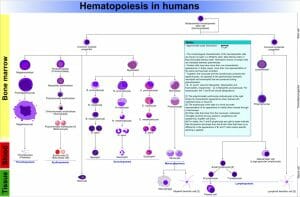Hematopoiesis Definition
Hematopoiesis is the term used to describe the differentiation of blood cells from hematopoietic stem cells. This process is continually required to maintain the levels of circulating blood cells in the body. There are three distinct linages of blood cells:
- Erythroid Lineage, which consists of reticulocytes and erythrocytes (red blood cells).
- Lymphoid Lineage, which consists of lymphocytes (B and T cells) as well as natural killer cells.
- Myeloid Lineage, which consists of macrophages, dendritic cells, granulocytes, and megakaryocytes, among others.
Hematopoiesis is highly evolutionarily conserved, and hematopoietic stem cells are self-renewing. Thus, this process provides an excellent model for the study of cellular differentiation, the development of cancer, and the role of stem cells in the natural aging process.
Hematopoiesis Process
Depending on the specific life stage, hematopoiesis occurs in different locations throughout the body, or even outside the body (e.g., embryos). In the developing embryo, hematopoiesis first occurs in the yolk sac and transitions to the spleen, liver, and lymph nodes. This first wave of hematopoiesis is termed the primitive wave and is characterised primarily by the erythroid progenitor which leads to the differentiation of erythrocytes, needed to supply the growing fetus with oxygen. The blood islands and embryonic yolk sac are the most common sites of the erythroid progenitor during this period, which is transient because erythroid progenitors are not self-renewing. Later, as the bones form, hematopoiesis begins to take place in the bone marrow. During childhood, the most common sites of hematopoiesis are the long bones, primarily the femur, tibia, and fibula. In adults, hematopoiesis transitions to the pelvis, sternum, cranium, and vertebrae. Although the process of hematopoiesis is initiated in the bone marrow, further maturation occurs in other lymphoid organs, including the spleen, thymus, and lymph nodes. As the organism develops past the embryonic stage, hematopoiesis requires the use of multipotential hematopoietic stem cells and is termed definitive hematopoiesis. Such multipotential hematopoietic stem cells arise from the aorta-gonad-mesonephros region of the embryo (process illustrated below).

The process of hematopoiesis is highly regulated by the presence of cytokines, which ultimately regulate the differentiation of multipotential hematopoietic stem cells into specific cell types through the activation of transcription factors. The importance of cytokines has been demonstrated in animal models, which have shown that particular cytokines induce the differentiation of specific cell types. For example, the presence of granulocyte macrophage-colony stimulating factor will promote the myeloid lineage, ultimately leading to the differentiation of granulocytes and macrophages. Such cytokines are termed growth factors, and are required throughout the process of hematopoiesis, functioning to activate transcription factors. The requirement of such factors can be observed in several diseases, in which the failure of hematopoietic transcription factor activation results in a severe immunocompromised status or cancer.
The typical process of hematopoiesis involves the differentiation of the multipotential hematopoietic stem cell into either the common myeloid or lymphoid progenitor. Next, depending on the cytokines and resulting transcription factors that are activated, the myeloid progenitor can differentiate into a myeloblast which can lead to granulocyte (basophils, neutrophils, or eosinophils) or monocyte (macrophages and dendritic cell) development. The common myeloid progenitor can also lead to the differentiation of megakaryocytes into platelets, or erythroblasts into erythrocytes. From the common lymphoid progenitor, lymphoid dendritic cells can form directly. In addition, the differentiation of the common lymphoid progenitor into a lymphoblast leads to the further development of natural killer cells or lymphocytes (T and B cells). Once activated in secondary lymphoid organs, B cells further differentiate into plasma cells, which secrete antibodies. The process of hematopoiesis is illustrated below:

Quiz
1. An early site of hematopoiesis during embryonic development is:
A. Yolk sac
B. Liver
C. Bone marrow
D. A and B only
D. A and C only
2. Chemotherapy often causes neutropenia (low levels of circulating neutrophils) which is commonly treated with GM-CSF (granulocyte macrophage-colony stimulating factor). Which of the following best describes the mechanism by which GM-CSF impacts neutrophil levels?
A. GM-CSF stimulates differentiation of the common myeloid progenitor into myeloblasts and granulocytes.
B. GM-CSF stimulates the differentiation of the common myeloid progenitor into lymphoblasts and natural killer cells.
C. GM-CSF stimulates the differentiation of the common myeloid progenitor into erythrocytes.
D. GM-CSF stimulates the differentiation of megakaryocytes into granulocytes.
References
- Dzierzak E. (2002). Hematopoietic stem cells and their precursors: developmental diversity and lineage relationships. Immunol Rev. 187:126-38.
- Dzierzak E. (2005). The emergence of definitive hematopoietic stem cells in the mammal. Curr Opin Hematol. 12(3):197-202.
- Jagannathan-Bogdan M and Zon L. (2013). Hematopoiesis. Development. 140(12): 2463–2467.
- Mehta HM, Malandra M, and Corey SJ. (2015). G-CSF and GM-CSF in Neutropenia. J Immunol. 195(4):1341-9.
- Paik E and Zon L. (2010). Hematopoietic development in the zebrafish. Int J Dev Biol. 54: 1127-1137.
